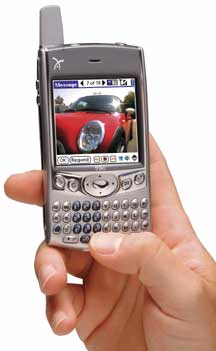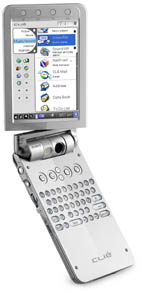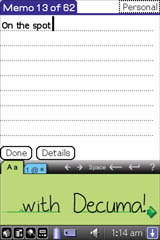June 2003
HP iPAQ h2215 review
See Pen Computing's review of the new HP iPAQ h2215. -- Posted Tuesday, June 24, 2003
New Pocket PCs
The following Pocket PC hardware products were announced in conjunction with Microsoft's unveiling of Windows Mobile 2003 for Pocket PC: HP announced four new products. One, the HP iPAQ 2200 Series is totally new. The others, the iPAQ 1930/1940, the iPAQ 5150 and 5550 are updated versions of existing products. Toshiba, likewise, upgraded existing platforms. The top-of-the-line e750 Series gets the new OS. The old e330 Series becomes the 350 Series with the new OS. Look for reviews on this site and the next issue of Pen Computing Magazine. They are joined by newcomer JVC which announced two high-end multimedia Pocket PCs, the MP-PV131 and MP-PV331. -- Posted Monday, June 23, 2003
Microsoft unveils new version of Pocket PC
Microsoft unveiled an updated version of the Pocket PC OS and platform. Initially thought to be called "Pocket PC 2003," Microsoft instead chose "Windows Mobile" to describe CE .NET-based platforms for mobile devices such as Pocket PCs and SmartPhone. While undoubtedly adding to the traditional nomenclature confusion, this is the way it is.
In any case, those who see Windows Mobile for the Pocket PC for the first time won't notice much of a difference between it and Pocket PC 2002. That caused one notable industry columnist to quip, weeks ago, that Microsoft appears to view Pocket PC as a "mature" platform without further need for refinement. While it DOES look that way, it is only half the truth. The new version of Pocket PC/Windows Mobile sits on top of Windows CE .NET 4.2, a far more competent and powerful basis than the old Windows CE 3.0. In addition, Microsoft has added numerous important features, impovements, updates, enhancements under the hood, all geared towards making the Pocket PC a better, stronger, more reliable platform that fits more seamlessly into overall corporate systems and Microsoft's .NET strategy than ever before.
Among the really cool stuff: if you have a wireless LAN onbord, you no longer even need to configure it. It does that all by itself and simply connects, asking you questions only when needed or appropriate. Security has been beefed up considerably, with, among other things, 802.1x available.
Look for a complete and detailed description of the new platform on this site and in the next issue of Pen Computing Magazine. Windows Mobile 2003 for Pocket PC may not be what a lot of people wanted or expected, but it sure is what we all needed.
-- Posted Monday, June 23, 2003
Handspring announces new Treo 600
 Details of Handspring's new Treo 600 were released today. The 600 is actually two models with the same name, the difference being the radio inside. One will be a CDMA/1xRTT version for North America, and the other will be a four-band GSM/GPRS, probably covering every GSM system in the world.
Details of Handspring's new Treo 600 were released today. The 600 is actually two models with the same name, the difference being the radio inside. One will be a CDMA/1xRTT version for North America, and the other will be a four-band GSM/GPRS, probably covering every GSM system in the world.
The 600 is narrower and taller than the old Treos, and has a sharper look. It's lightweight without that plastic feel. The new five-way navigator combined with the keyboard makes the stylus practically unnecessary, unless you want to doodle. Otherwise, it's just down to business with the new design. Up to 26 of the keyboard keys can be pre-programmed to perform a given function, like sending an email or SMS to a certain person, or quickly dialing a number--even going to a favorite website. They've taken the integration of the five-way further than Palm SG, allowing it to select among status buttons and pull-down menus by navigating in all directions.
The screen remains at 160 x 160, but the 600 includes a 640 x 480 camera for capturing snapshots that you can email or use for the "picture caller ID" feature. RAM is 32MB, and an SD/SDIO slot is available for memory expansion. The built-in Li-ion battery is good for six hours talk time and two weeks organizer use. It runs an as-yet-unnamed ARM processor and Palm OS 5.2.1. Dimensions are 4.41 x 2.26 x .87 inches. Weight is 5.9 ounces for the GSM version and 6.2 ounces for CDMA. The unit is designed for easy carrier customization, which can include different software bundles and different case color schemes. Pricing is expected to be between US$400 and US$500. For more about the business side of the story, see the excellent article by Richard Shim on C|Net, with a link to the video of an interview with Handspring's Greg Shirai, as well as Handspring's own site, which has a video of Jeff Hawkins showing off the device. The phones are expected to be available from various carriers this Fall. -- Posted Wednesday, June 18, 2003
Sony introduces new NX-series handhelds
 Sony USA today announced US versions of the NX80V and NX73V handhelds previously announced for the Japanese market. The new design is slightly smaller, and features a pop-out CF/WiFi card slot at the back. The NX80V has a 1.3 megapixel digital camera, which includes an illumination LED lamp instead of a flash. The NX73V (click for picture) has a 300K pixel camera, with no lamp. The NX80V also features a backlit keyboard; it is unclear whether the 73 has the same, but given that both body styles are the same it is likely. Both units are a refinement of the original NR and NX clamshell designs. Many will be most happy that the new retractable WiFi slot also supports CF memory expansion. The only bad news about CF support is that JPEG photos and MPEG movies cannot be stored or played from a CF card. Memory stick will still be required. It is not clear how long this limitation will exist.
Sony USA today announced US versions of the NX80V and NX73V handhelds previously announced for the Japanese market. The new design is slightly smaller, and features a pop-out CF/WiFi card slot at the back. The NX80V has a 1.3 megapixel digital camera, which includes an illumination LED lamp instead of a flash. The NX73V (click for picture) has a 300K pixel camera, with no lamp. The NX80V also features a backlit keyboard; it is unclear whether the 73 has the same, but given that both body styles are the same it is likely. Both units are a refinement of the original NR and NX clamshell designs. Many will be most happy that the new retractable WiFi slot also supports CF memory expansion. The only bad news about CF support is that JPEG photos and MPEG movies cannot be stored or played from a CF card. Memory stick will still be required. It is not clear how long this limitation will exist.  The camera rotates up to 300 degrees, and the battery life has been extended from 10 days to 14 days, according to Sony. Continuous playback of MP3/ATRAC3 files has been raised from around 4 hours on the NX70V to about 7 hours. The 80 units are champagne finish, and the 73 units are black. The 1.3 megapixel camera on the NX80 also has a neutral density filter that can be switched into place in bright light. Perhaps as an alternative to Graffiti, new character-based handwriting recognition is included from Decuma of Sweden. Finally, the new units have 32MB Flash memory upon which all major applications are preloaded; applications that were previously installed manually from the PC. The NX80V has 32MB RAM and will retail for US$599, and the 16MB NX73V will sell for US$499. http://www.sonystyle.com/clie/ -- Posted Monday, June 16, 2003
The camera rotates up to 300 degrees, and the battery life has been extended from 10 days to 14 days, according to Sony. Continuous playback of MP3/ATRAC3 files has been raised from around 4 hours on the NX70V to about 7 hours. The 80 units are champagne finish, and the 73 units are black. The 1.3 megapixel camera on the NX80 also has a neutral density filter that can be switched into place in bright light. Perhaps as an alternative to Graffiti, new character-based handwriting recognition is included from Decuma of Sweden. Finally, the new units have 32MB Flash memory upon which all major applications are preloaded; applications that were previously installed manually from the PC. The NX80V has 32MB RAM and will retail for US$599, and the 16MB NX73V will sell for US$499. http://www.sonystyle.com/clie/ -- Posted Monday, June 16, 2003
Pen&Internet scores major deal
Pen&Internet, the developer of riteMail handwriting email software signed an OEM agreement with Chinese Dopod Communications, a manufacturer and distributor of the Dopod 686 Pocket PC Phone which is made by HTC and sold under various names, including the T-Mobile Pocket PC Phone reviewed in detail in the September 2002 issue of Pen Computing Magazine. Under the agreement, riteMail will be pre-loaded on every Dopod 686 Pocket PC Phone. -- Posted Thursday, June 12, 2003
Universe set straight again, but at a huge price
It was with a great sloshing of differing emotions that I listened to today's news conference announcing Palm's acquisition of Handspring. On the one hand it is a move I predicted in 1999 (see below), and one I think can be good for both companies if handled properly. On the other hand, it's a merger that should never have been necessary, because Handspring should never have been created. And to hear Eric Benhamou, current Chairman and interim CEO of Palm, Inc.--as well as the cause of Hawkins, Dubinsky, and Colligan's leaving to form Handspring in the first place--say that the merger "...will serve as a powerful catalyst to transform the landscape of the handheld industry" just makes me want to retch. The handheld industry would be far more powerful, and in need of no transformation, had Benhamou just spun off Palm when the three Palm founders asked in the first place. This will be the sixth major corporate swirl the still comparatively small Palm has taken, and I'll detail that and more in an upcoming emergency column (now completed). Meanwhile, talk amongst yourselves. Topic: what name do you give the merged company: PalmSpring? Halm? Ping? Pang would perhaps be more apt given the continuing convlusions in a company that continues to struggle financially despite fantastic success at saturating the market with its hardware and software in the face of attacks from Microsoft. Also, read the excerpt from the end of my October 1999 column:
Spinoffs
Coming as no coincidence the day before Handspring's Visor announcement, 3Com's CEO Eric Benhamou announced that Palm Computing would be spun off from 3Com. It came as no surprise, at least not to industry watchers who've been circulating rumors for months that 3Com and Palm were a mismatch, and that there were suitors surrounding 3Com who didn't like how Palm fit into the company.
I believe it may have surprised Hawkins and Dubinsky though, who left 3Com to form their own company last November with positive words on their lips about how nice it would be to work for a startup company again. It sounded to me like they weren't enjoying the bureaucracy of 3Com too much, and wanted to make some of their own decisions about the product they'd created. When they initially sold Palm Computing to US Robotics, a strong and forward-thinking company, I'm sure they had no idea 3Com would quickly come in and gobble them both up like some famous sports stadium.
The San Jose Mercury News reported on September 14 that Hawkins and Dubinsky, Palm and Handspring's original founders, "took a handful of key staff with them to their new venture. But both said they talked extensively to 3Com about selling off Palm before deciding to leave. 'If they had spun us out, I'd still be there,' said Hawkins."
It's a scandal, if you ask me. I doubt there was sinister intent on 3Com's part, but depriving a company of its brainpower and then spinning it off is just not clear thinking. The clumsiness displayed in such a move makes me wonder about 3Com's future.
The good news is that Palm won't be a part of 3Com's future. In a stroke of good luck, reasoning in his simple and slow mind, the giant has set them free, and Palm can grow and innovate as the market requires. If we're really lucky, perhaps in six to eight months, Palm and Handspring will do a little merger of their own. -Shawn Barnett, October 1999, Pen Computing Magazine "Big Changes for the little Palm" -- Posted Wednesday, June 4, 2003
Initial reaction to Palm buying Handspring
Now Palm is buying Handspring in a stock transaction. Those who hold Handspring stock will get 0.09 shares of Palm stock, with the disparity in stock prices largely explained by Palm stock's 1:20 "reverse split" a year or so ago (i.e. you bought 2,000 shares when Palm peaked and then all of a sudden only had a hundred, each being worth less than one of the orginal 2,000). So the saga goes full term. Hawkins et al split off from Palm to make better and more innovative Palms, did so for a while with the original Visors and the brilliant Springboard expansion slot, then seemed to lose interest and meander off into PDA cellphones, thus stranding millions of Handspring PDA fans and owners. My own interpretation of this odd turn of events was that brilliant mastermind Hawkins had simply become restless and bored and sought new challenges for his great mind. Now they say he and Donna Dubinsky and Ed Colligan will all assume management positions in the new and unified Palm, so as to better fend off big, bad Microsoft, the 1,600 pound gorilla that, in actuality, has gone out of its way to not ruffle a single hair on Palm's corporate head over the past couple of years for fear of new allegations of corporate bullying. So the Handspring experiment is over, and a very large amount of money in initial stock value is gone. That is not what we expected. And that's not the way it ought to be. -- Posted Wednesday, June 4, 2003
 Details of Handspring's new Treo 600 were released today. The 600 is actually two models with the same name, the difference being the radio inside. One will be a CDMA/1xRTT version for North America, and the other will be a four-band GSM/GPRS, probably covering every GSM system in the world.
Details of Handspring's new Treo 600 were released today. The 600 is actually two models with the same name, the difference being the radio inside. One will be a CDMA/1xRTT version for North America, and the other will be a four-band GSM/GPRS, probably covering every GSM system in the world. 
